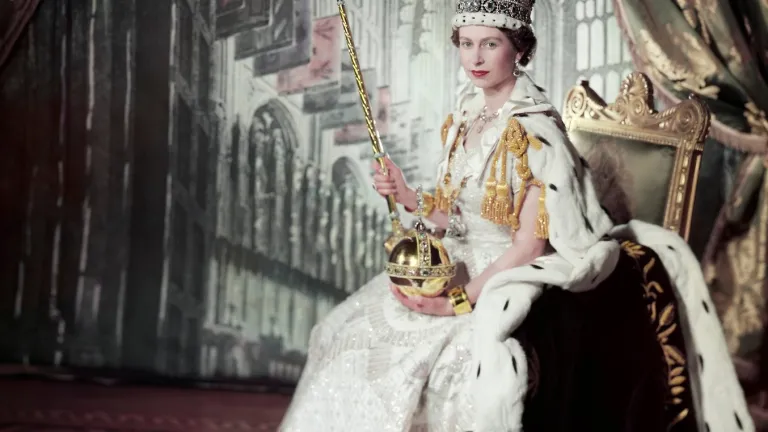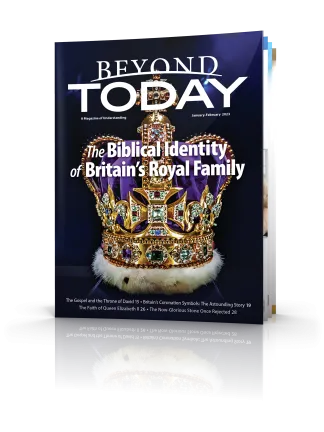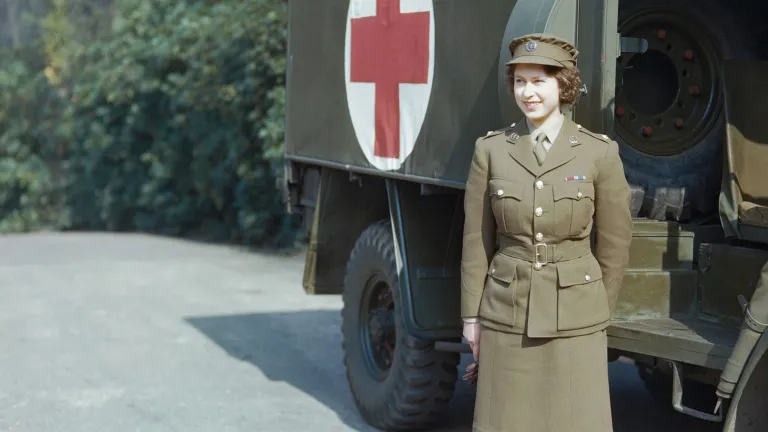Britain’s Coronation Symbols: The Astounding Story

Embedded in the pageantry of the coronation of Britain’s monarchs is a remarkable story—one that ties the British crown and throne to the kings and patriarchs of the Bible.
When Queen Elizabeth II was crowned as head of church and state in 1953, highly meaningful symbols were used in the ceremony that have biblical and spiritual implications. Emblems of majesty and dominion contributed to the strength and dignity of this ancient throne. At its heart, this was a religious act.
When King Charles III, the new head of the Commonwealth, is crowned in May 2023, 70 years after his mother was, the same symbols will likely be brought forward in his time of solemn dedication as sovereign of the United Kingdom and other Commonwealth realms such as Australia, Canada and New Zealand.
His crowning will take place in a church building intended for the worship and service of God. The spiritual aspect of the ceremony will be by far the most important, and we cannot fail to be struck with the similarity between the coronation of Britain’s rulers and that of the kings of the dynasty and lineage of ancient Israel’s King David—called in the Bible “the house of David.”
Let’s examine some of the symbols that were used in the crowning of Queen Elizabeth II, which most likely will also be part of the coronation ceremony of King Charles III.
The Holy Bible
The Holy Bible will be taken from the church altar and presented to King Charles. If the ceremony follows that of Elizabeth II, the Archbishop of Canterbury, senior cleric of the Church of England, will then say these words: “Our gracious king, to keep your Majesty ever mindful of the law and Gospel of God as rule for the whole life and government of Christian princes, we present you with this Book, the most valuable thing that this world affords.”
This is very reminiscent of the command given to kings by God in Deuteronomy 17. There a newly chosen king was instructed to read the words of God all the days of his life so that he would learn to fear the Lord his God, keep all the words of the law and statutes, living and governing by them (verses 18–19).
The anointing
What follows will no doubt be the most important aspect of King Charles’ crowning. He will be anointed with specially prepared oil on the palms of his hands, on his breast and on the crown of his head. The words then spoken will harken back to the anointing of King Solomon himself. Here is what was said when Elizabeth II was anointed:
“Be thy hands anointed with holy oil.
“Be thy breast anointed with holy oil.
“Be thy head anointed with holy oil, as kings, priests, and prophets were anointed:
“And as Solomon was anointed king by Zadok the priest and Nathan the prophet, so be thou anointed, blessed and consecrated Queen over the peoples, whom the Lord thy God hath given thee to rule and govern, in the name of the Father, and of the Son, and of the Holy Ghost. Amen.”
These words emphasize that the coronation of the Queen or King is not a civic ceremony, but rather a religious service for setting apart a person for a holy office—a divinely appointed position. The British people see the king as “the Lord’s anointed,” the representative to the people of the King of Kings.
The prayer at the conclusion of the anointing of King Ethelred II, who was crowned in A.D. 978, very much illustrates the biblical roots of the Angles and Saxons, ancestors of today’s English people. A portion of it states:
“May the Almighty bless thee with the blessings of the heaven above . . . and may the blessing of the ancient fathers, Abraham, Isaac, and Jacob, be heaped upon thee!”
In the full prayer for King Ethelred, the references to verses in the Old Testament are very relevant—for the kings of the ancient house of David were anointed just as King Charles will be anointed.
The spurs and sword
Following the anointing of the king comes the delivery of the regalia—the spurs and the sword. These insignia of office, presented after the king is anointed, are tokens that he is now a consecrated sovereign—a ruler set apart for God’s service.
The touching of the spurs, an emblem of chivalry, and the girding of the sword, are then both offered on the altar in the church—signifying the king’s intent, under God, to rule in justice, equity and mercy. Scripture reminds us in Zechariah 7:9–10 of this key responsibility.
The royal robe and orb
The royal robe of cloth and gold is then placed on the king by the Dean of Westminster, with the Lord Great Chamberlain fastening the clasps. If history repeats itself, the archbishop will state: “Receive this imperial robe, and the Lord your God endue you with knowledge and wisdom, with majesty and with power from on high: the Lord clothe you with the robe of righteousness and with garments of salvation. Amen.”
The orb, the golden sphere with the cross on top meant to symbolize the sovereignty of Christ over the world, is then brought from the altar by the dean and delivered into the king’s hand by the archbishop, who exhorts: “Receive this orb set under the cross, and remember that the whole world is subject to the power and empire of Christ our Redeemer.”
The ring and scepters
The ring, which is placed on the fourth finger of the monarch’s right hand, is often referred to as “the wedding ring of England.” The king is symbolically married to the nation. And the ring is a symbol of power and honor.
After putting on the ring, the archbishop places into the king’s hands two scepters or royal rods, one with a cross and the other with a dove. The first represents kingly power and justice through Christ, while the second pictures equity and mercy through the Holy Spirit.
We find in the Bible similar imagery with allusions to the scepter as representative of regal authority and symbol of righteous administration: “But to the Son He says: ‘Your throne, O God, is forever and ever; a scepter of righteousness is the scepter of Your kingdom’” (Hebrews 1:8).
The crown
At the conclusion and climax of the coronation ceremony, after being invested with the insignias and emblems of royalty, the king will then receive his crown.
The St. Edward’s Crown—the crown of England—will most likely be used for the actual coronation. The rim of the crown is encircled with 12 large stones of varied colors, each surrounded by diamonds.
Of interest and relevance is the fact that the high priest of ancient Israel wore a breastplate set with 12 precious stones to represent the unity of the 12 tribes. And in the book of Revelation we read of the New Jerusalem having 12 foundations of these precious stones, showing lasting unity and strength.
If the ceremony follows that of Elizabeth II, the archbishop will lay the crown on the altar and pray the following:
“O God, the crown of the faithful: Bless we beseech thee this crown, and so sanctify thy servant Charles upon whose head this day thou dost place it for a sign of royal majesty, that he may be filled by thine abundant grace with all princely virtues: through the King Eternal Jesus Christ our Lord. Amen.”
Then the archbishop will come from the altar and reverently place the crown on the king’s head—the king still sitting in King Edward’s Chair. At this point the people will repeatedly shout, “God save the king!”
And so, we are reminded again of the deep biblical and spiritual significance of the coronation service. It is similar to the rejoicing and coronation of King Solomon, and deliberately so.
The chair and “Stone of Destiny”
The oak coronation chair on which the king will be seated dates from the time of King Edward I (who reigned from 1272 to 1307). King Edward had the chair specially designed to enclose under the seat a remarkable relic brought to England from Scotland—the Stone of Scone, or Stone of Destiny, on which Scottish kings had been crowned. The stone was returned to Scotland in 1996 but is being temporarily brought to London for the crowning. It’s the oldest item still used today in the coronation ceremony.
The Stone of Destiny is an oblong block of sandstone 26 inches long by 16 inches wide and 10½ inches deep. Similar stone is found near Bethel in modern-day Israel. Tradition claims this is the very stone Abraham’s grandson Jacob used as a pillow the night he had his famous dream of angels ascending and descending a staircase which reached to heaven. Jacob blessed and anointed the stone with oil and may have later taken it with him as a special possession (Genesis 28:11–18).
Many British monarchs have been crowned on the Stone of Destiny.
And this harkens back to the use of a pillar stone in the coronation ceremonies of kings of the line of David in ancient Judah—as we see mentioned in regard to Kings Joash and Josiah
(2 Chronicles 23:13; 2 Kings 11:12-14; 23:3). This was conceivably the same stone Jacob anointed.
(You can read much more about the history and traditions surrounding this stone in our free eBook The Throne of Britain: Its Biblical Origin and Future)
The enthronement
King Charles will then go to his throne and be lifted up into it by the archbishop and other bishops and noble peers. And then all the assembled officers and nobles will, if as before, say in conclusion:
“. . . And the Lord God Almighty, whose ministers we are, and the stewards of His mysteries, establish your throne in righteousness, that it may stand fast forevermore . . .”
The earlier form of the coronation ceremony, 1937 and before, added the words, “. . . like as the sun before him, and as the faithful witness in heaven. Amen.”
This final phrase of the enthronement speech was spoken in Scripture in reference to the throne of David, the throne of the Lord over Israel: “Once I have sworn by My holiness; I will not lie to David: His seed shall endure forever, and his throne as the sun before Me; it shall be established forever like the moon, even like the faithful witness in the sky” (Psalm 89:35-37, emphasis added).
“God save the king!”
When the coronation service is ended, all the people will shout: “God save King Charles. Long live King Charles. May the king live forever!”
This reminds us of the support, submission and loyalty ancient Israel gave King Solomon: “Then Solomon sat on the throne of the Lord as king instead of David his father, and prospered; and all Israel obeyed him. All the leaders and the mighty men, and also all the sons of King David, submitted themselves to King Solomon” (1 Chronicles 29:23-24).
Not only the coronation, but the people of the Commonwealth and their brother English-speaking nation, the United States, are linked and bound up in the Bible. It’s all part of an astounding story stretching back thousands of years.
There’s a reason the laws of the nations of the British Empire and the United States are based on the Bible. There’s a reason their families have fought for justice only Jesus Christ can bring. The story of the nations of the British Empire and the United States bear witness to the power of God even as their people pray for His Kingdom to come. The very throne of David is embedded in the royal throne of Britain—to which, as foretold in Isaiah 9:7, Jesus Christ will return and claim as His own!





